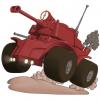Realistic is a very misleading word the way we know it. When people say I want a game to look "realistic", what they really want is to have it look like it was filmed by a Holywood studio with special lighting setups (which may vary for different shots), makeup, particular hair styles that always highlight nice places and cover the not so pretty places, special lenses, and particular camera angles with a particular camera movement.
You know the phrase "even the girl from the fashion magazine doesn't look like the fashion model in the magazine" ? Same applies to "realistic" graphics, because people expect game's graphics to look like people in a magazine, TV shows, and movies. Which isn't realistic at all.
Therefore to look realistic we have to mimic what they do: Once we figure out the math stuff (proper BRDF, use HDR, Depth of field, wind effects, noise for a shaky camera effect), we need to setup lighting as in movie production (i.e. 3-point lighting is very popular), have the characters perform fashion-model-like walks for females, movie-like poses (3 point landing, anyone?), account for the 12 principles of animation, place the camera in strategic places, have camera shots change at the right times, have the depth of field focus what's important and leave what's unimportant out of focus.
Of course, high resolution textures, high polycount, motion capture and global illumination helps a lot; but it will only get you so far.
And of course, all of these "rules" can be broken. If you know what you're doing and know when to break them, it still looks good. When you don't, it looks crap. Just like crappy movies or your grandma's pictures (no offense to your grandma!).













